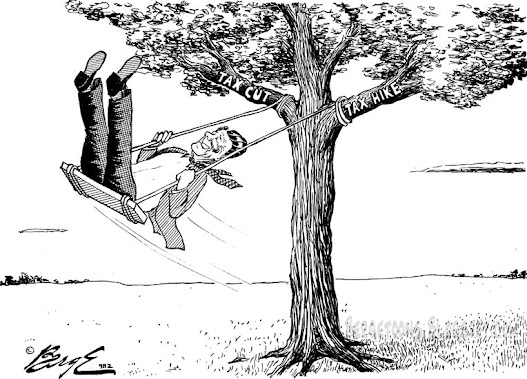Good heavens! It's almost October and I haven't hauled out a bunch of my old September cartoons yet!
 |
| in UW-Parkside Ranger, September 9, 1982 |
Ronald Reagan's legacy rests upon his promises to cut taxes, but he raised them, too. In fact, if one measures tax changes as a percentage of Gross Domestic Product, his 1982 tax hike was the largest in modern U.S. history — no matter what Republican attack ads have tried to tell you about Bill Clinton or Barack Obama, or will tell you about Joe Biden.
The 1980s tax increases are less well-known, in part because they didn't involve increases in individual income tax rates. The biggest, the Tax Equity and Fiscal Responsibility Act of 1982, increased revenue mainly by tightening up rules on depreciation, leasing, contract accounting and investment tax credits. The Social Security Amendments of 1983 sped up planned increases in payroll tax rates, among other things. The Deficit Reduction Act of 1984 changed rules on interest exclusions, income averaging and such. The Omnibus Budget Reconciliation Act of 1987 closed a few loopholes and extended a telephone excise tax. And the Tax Reform Act of 1986, while it lowered the top individual income tax rate to 28 percent from 50 percent, contained enough offsetting changes that, for the first two years after enactment, it raised tax revenue.
And he still ended up leaving what was, in 1989, by far the biggest federal deficit in history.
 |
| in UW-Milwaukee Post, September 28, 1992 |
Reagan came to office promising to tackle the much tamer deficit left by Jimmy Carter; billionaire H. Ross Perot made the same promises in 1992 about George H.W. Bush's deficit. And, also like Reagan, he was maddeningly evasive about how he was going to accomplish it.
 |
| in The Biz (Business Journal of Greater Milwaukee), October, 2002 |
But enough about fiscal policy. Here's a full-color cartoon I drew for The Biz, a flashy little quarterly insert published in The Business Journal for a few years in the 'aughts. The Biz was printed on a brighter, magazine-quality grade of paper than the standard newsprint of its parent journal.
My regular editorial cartoons for them illustrated the staff editorial and were black-and-white TIFF files. The Biz was intended to attract and engage younger readers, so the editors wanted color. They would call on me when they had an article that didn't lend itself to color photography.
I didn't have software with CMYK color capability when I was drawing cartoons for The Biz; the RGB .jpeg files I sent them came out a bit more drab in print. Black, the color missing from RGB formatting, came out just fine; but you can notice that the bright magenta in the young employee's shirt became a mild lavender in print, and his neon green mohawk is a tamer shade.
The colors you see here on your screen do not necessarily appear the same in print. Screen colors are produced by light; print colors are produced by ink. Since I started putting out color cartoons in CMYK format in 2012, I've only ever had one opportunity to see how my color cartoons look in print.
 |
| for Q Syndicate, September, 2012 |
This was not that cartoon.
My opportunity would come three years later, when was in Columbus, Ohio, for the annual convention of the Association of American Editorial Cartoonists. But like this cartoon, the cartoon I found in Outlook involved persons of color, and it was a relief to see how nicely their skin color appeared in print.
Drawing for LGBTQ+ media, I try from time to time to depict more beefcake than I might if I were still drawing for the Business Journal. (I've suspected that my setting one Business Journal cartoon about exclusively male boardrooms in a sauna is what got that cartoon spiked.) Sure, I could have set this cartoon on the sidelines or in the management guy's office rather than the locker room. Brendan Ayanbadejo rocks a bow tie and three piece suit every bit as well as he does a towel.
But while I'm sure the editors and publishers subscribing to my cartoons are Very Serious Journalists, I also know that this may have gotten some of their readers to pause on the editorial page just a little bit before flipping on to the feature interview of Hollywood's Hunk of the Month.
✍
I'll be in Columbus again next month for another AAEC convention — only the second one of these that I will have attended. Sadly, Outlook ceased publication in 2017, so that 2015 cartoon will remain the only one letting me know whether I cut it as a colorist.
.jpg)
No comments:
Post a Comment